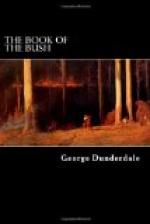ON THE NINETY-MILE.
A home by A REMOTER sea.
The Ninety-Mile, washed by the Pacific, is the sea shore of Gippsland. It has been formed by the mills of two oceans, which for countless ages have been slowly grinding into meal the rocks on the southern coast of Australia; and every swirling tide and howling gale has helped to build up the beach. The hot winds of summer scorch the dry sand, and spin it into smooth, conical hills. Amongst these, low shrubs with grey-green leaves take root, and thrive and flourish under the salt sea spray where other trees would die. Strange plants, with pulpy leaves and brilliant flowers, send forth long green lines, having no visible beginning or end, which cling to the sand and weave over it a network of vegetation, binding together the billowy dunes.
The beach is broken in places by narrow channels, through which the tide rushes, and wanders in many currents among low mudbanks studded with shellfish—the feeding grounds of ducks, and gulls, and swans; and around a thousand islands whose soil has been woven together by the roots of the spiky mangrove, or stunted tea-tree. Upon the muddy flats, scarcely above the level of the water, the black swans build their great circular nests, with long grass and roots compacted with slime. Salt marshes and swamps, dotted with bunches of rough grass, stretch away behind the hummocks. Here, towards the end of the summer, the blacks used to reap their harvest of fat eels, which they drew forth from the soft mud under the roots of the tussocks.
The country between the sea and the mountains was the happy-hunting-ground of the natives before the arrival of the ill-omened white-fellow. The inlets teemed with flathead, mullet, perch, schnapper, oysters, and sharks, and also with innumerable water-fowl. The rivers yielded eels and blackfish. The sandy shores of the islands were honey-combed with the holes in which millions of mutton-birds deposited their eggs in the last days of November in each year. Along many tracks in the scrub the black wallabiesand paddy-melons hopped low. In the open glades among the great gum-trees marched the stately emu, and tall kangaroos, seven feet high, stood erect on their monstrous hind-legs, their little fore-paws hanging in front, and their small faces looking as innocent as sheep.
Every hollow gum-tree harboured two or more fat opossums, which, when roasted, made a rich and savoury meal. Parrots of the most brilliant plumage, like winged flowers, flew in flocks from tree to tree, so tame that you could kill them with a stick, and so beautiful that it seemed a sin to destroy them. Black cockatoos, screaming harshly the while, tore long strips of bark from the messmate, searching for the savoury grub. Bronzed-winged pigeons, gleaming in the sun, rose from the scrub, and flocks of white cockatoos, perched high on the bare limbs of the dead trees, seemed to have made them burst into miraculous bloom like Aaron’s rod.




